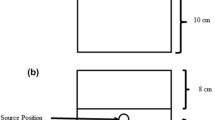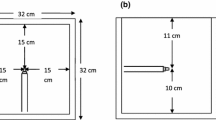Abstract
Dose calculations in brachytherapy planning typically don’t take into account inhomogeneities and the material of applicators. We evaluated the justification of the latter by investigating the dose delivered in 192-Ir interstitial implants employing plastic catheters and steel needles using miniature LiF: Mg, Cu, P thermoluminescence dosimeters (TLDs) which fit in the applicators. Within the uncertainty of the measurement (+/−5%) no difference could be found in the dose distribution from 192Ir in steel needles or plastic catheters. Computerized treatment planning (Philips/ADAC Pinnacle) was in good agreement with the measured data.
Similar content being viewed by others
References
Duchesne, G. M., Das, R., Toye, W. and See, A.,Dose distribution and morbidity after high dose rate brachytherapy for prostate cancer: influence of V150 and V200 parameters. Australas. Radiol., 46: 384–389, 2002.
Vicini, F. A., Vargas, C., Edmundson, G., Kestin, L. and Martinez, A.,The role of high-dose rate brachytherapy in locally advanced prostate cancer. Semin. Radiat. Oncol., 13: 98–108, 2003.
Martin, T., Roddiger, S., Kurek, R., Dannenberg, T., Eckart, O., Kolotas, C., Heyd, R., Rogge, B., Baltas, D., Tunn, U. and Zamboglou, N.,3D conformal HDR brachytherapy and external beam irradiation combined with temporary androgen deprivation in the treatment of localized prostate cancer. Radiother. Oncol., 71: 35–41, 2004.
Nath, R., Anderson, L. L., Luxton, G., Weaver, K. A., Williamson, J. F. and Meigooni, A. S.,Dosimetry of interstitial brachytherapy sources: recommendations of the AAPM Radiation Therapy Committee Task Group No. 43. American Association of Physicists in Medicine. Med. Phys., 22: 209–234, 1995.
Nath R., Anderson L.L., Meli J.A., Olch A.J., Stitt J.A. and Williamson, J. F.,Code of practice for brachytherapy physics: report of the AAPM Radiation Therapy Committee Task Group No. 56. American Association of Physicists in Medicine. Med. Phys., 24: 1557–1598, 1997.
International Atomic Energy Agency.Commissioning and Quality Assurance of Computerized Planning Systems for Radiation Treatment of Cancer. IAEA Technical Reports Series No 430. IAEA: Vienna, 2004.
Hood, C., Duggan, L., Bazley, S., Denham, J., Budzanowski, M. and Kron, T.,LiF: Mg, Cu, P ‘pin worms’: miniature detectors for brachytherapy dosimetry. Radiat. Prot. Dosimetry., 101: 407–410, 2002.
Kron T.,Thermoluminescence dosimetry and its applications in medicine—Part 1: Physics, materials and equipment. Australas. Phys. Eng Sci. Med., 17: 175–199, 1994.
Duggan, L., Hood, C., Warren-Forward, H., Haque, M. and Kron, T.,Variations in dose response with x-ray energy of LiF: Mg, Cu, P thermoluminescence dosimeters: implications for clinical dosimetry. Phys. Med. Biol., 49: 3831–3845, 2004.
Horowitz Y. and Olko P.,The effects of ionisation density on the thermoluminescence response (efficiency) of Li F: Mg, Ti and LiF: Mg, Cu, P. Radiat. Prot. Dosimetry., 109: 331–348, 2004.
Meisberger, L., Keller, R. and Shalek, R.The effective attenuation in water of the gamma rays of gold 198, iridium 192, caesium 137, radium 226 and cobalt 60. Radiology, 90: 953–957, 1968.
Anagnostopoulos, G., Baltas, D., Geretschlaeger, A., Martin, T., Papagiannis, P., Tselis, N. and Zamboglou, N.,In vivo thermoluminescence dosimetry dose verification of transperineal 192 Ir high-dose-rate brachytherapy using CT-based planning for the treatment of prostate cancer. Int. J. Radiat. Oncol. Biol. Phys., 57: 1183–1191, 2003.
Duggan, L., Bucci, J. and Kron, T.Comments to: “In vivo TLD dose verification of transperineal 192-Ir HDR brachyhterapy using CT-based planning for the treatment of prostate cancer” (IJROBP 2003; 57: 1183-1191). Int. J. Radiat. Oncol. Biol. Phys. 59: 911, 2004.
Author information
Authors and Affiliations
Corresponding author
Rights and permissions
About this article
Cite this article
Hood, C., Duggan, L., Bazley, S. et al. Miniature LiF: Mg, Cu, P TLDs to study the effect of applicator material in 192-Ir brachytherapy. Australas. Phys. Eng. Sci. Med. 29, 300–302 (2006). https://doi.org/10.1007/BF03178394
Received:
Accepted:
Issue Date:
DOI: https://doi.org/10.1007/BF03178394




